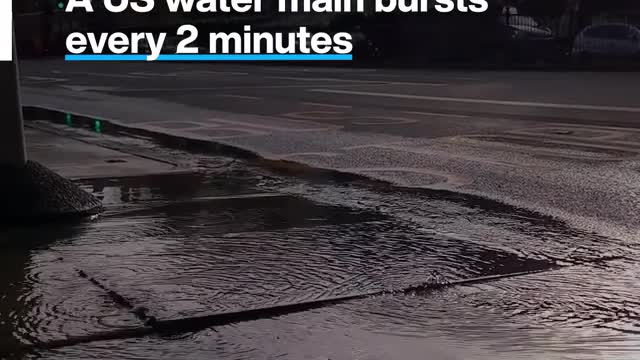Premium Only Content

Pipebots could stop water leaks.Pipebots patrolling UK’s water network next 5 years. #waterleakage
Pipebots could stop water leaks.Pipebots patrolling UK’s water network next 5 years. #waterleakage.
These smart mini-robots could soon clean and inspect pipes.
The maze of pipes underneath our homes and cities are tricky to access and therefore expensive to maintain.
A mini-robot, called Joey, has been developed that can independently find its way through underground pipes.
The robot is cheap to produce, smart, small and light – allowing it to move through pipes despite the challenging terrain it's faced with.
Researchers from the University of Leeds have developed the first mini-robot, called Joey, that can find its own way independently through networks of narrow pipes underground, to inspect any damage or leaks. Joeys are cheap to produce, smart, small, and light, and can move through pipes inclined at a slope or over slippery or muddy sediment at the bottom of the pipes. Future versions of Joey will operate in swarms, with their mobile base on a larger ‘mother’ robot Kanga, which will be equipped with arms and tools for repairs to the pipes.
Beneath our streets lies a maze of pipes, conduits for water, sewage, and gas. Regular inspection of these pipes for leaks, or repair, normally requires these to be dug up. The latter is not only onerous and expensive – with an estimated annual cost of £5.5bn in the UK alone – but causes disruption to traffic as well as nuisance to people living nearby, not to mention damage to the environment.
Now imagine a robot that can find its way through the narrowest of pipe networks and relay images of damage or obstructions to human operators. This isn’t a pipedream anymore, shows a new study in Frontiers in Robotics and AI by a team of researchers from the University of Leeds.
“Here we present Joey – a new miniature robot – and show that Joeys can explore real pipe networks completely on their own, without even needing a camera to navigate,” said Dr Netta Cohen, a professor at the University of Leeds and the final author on the study.
Joey is the first to be able to navigate all by itself through mazes of pipes as narrow as 7.5 cm across. Weighing just 70 g, it’s small enough to fit in the palm of your hand.
Pipebots project
The present work forms part of the ‘Pipebots’ project of the universities of Sheffield, Bristol, Birmingham, and Leeds, in collaboration with UK utility companies and other international academic and industrial partners.
First author Dr Thanh Luan Nguyen, a postdoctoral scientist at the University of Leeds who developed Joey’s control algorithms (or ‘brain’), said: “Underground water and sewer networks are some of the least hospitable environments, not only for humans, but also for robots. Sat Nav is not accessible undergound. And Joeys are tiny, so have to function with very simple motors, sensors, and computers that take little space, while the small batteries must be able to operate for long enough.”
Joey moves on 3D-printed ‘wheel-legs’ that roll through straight sections and walk over small obstacles. It is equipped with a range of energy-efficient sensors that measure its distance to walls, junctions, and corners, navigational tools, a microphone, and a camera and ‘spot lights’ to film faults in the pipe network and save the images. The prototype cost only £300 to produce.
Mud and slippery slopes
The team showed that Joey is able to find its way, without any instructions from human operators, through an experimental network of pipes including a T-junction, a left and right corner, a dead-end, an obstacle, and three straight sections. On average, Joey managed to explore about one meter of pipe network in just over 45 seconds.
To make life more difficult for the robot, the researchers verified that the robot easily moves up and down inclined pipes with realistic slopes. And to test Joey’s ability to navigate through muddy or slippery tubes, they also added sand and gooey gel (actually dishwashing liquid) to the pipes – again with success.
Importantly, the sensors are enough to allow Joey to navigate without the need to turn on the camera or use power-hungry computer vision. This saves energy and extends Joey’s current battery life. Whenever the battery runs low, Joey will return to its point of origin, to ‘feed’ on power.
Currently, Joeys have one weakness: they can’t right themselves if they inadvertently turn on their back, like an upside-down tortoise. The authors suggest that the next prototype will be able to overcome this challenge. Future generations of Joey should also be waterproof, to operate underwater in pipes entirely filled with liquid.
#innovation #robots #leaks #uk #watersolutions #drainagesystem #pipes
-
 LIVE
LIVE
Barry Cunningham
7 hours agoBREAKING NEWS: PRESIDENT TRUMP SET TO TAKEOVER CHICAGO AND BOSTON!
1,462 watching -
 LIVE
LIVE
SpartakusLIVE
1 hour agoThe BADDEST Duo in WZ Exhibits PEAK Physique || Duos w/ Sophiesnazz to start, quads later
559 watching -
 LIVE
LIVE
LumpyPotatoX2
1 hour agoSunday Funday on HellDivers - #RumbleGaming
91 watching -
 3:11:52
3:11:52
Esports Awards
4 hours agoEsports Awards: Decade Awards 2025
41.2K3 -
 1:02:58
1:02:58
Sarah Westall
2 hours agoMILITARY WHISTLEBLOWER: How Social Media Military Level Psyops are Manipulating You w/ Patrick Bergy
6.03K3 -
 30:41
30:41
Stephen Gardner
2 hours ago🔥WHITE HOUSE GETS UNEXPECTED BIG WIN!
10.4K10 -
 9:39
9:39
MattMorseTV
4 hours ago $0.31 earnedVance just DROPPED a BOMBSHELL.
10.4K41 -
 2:40:14
2:40:14
DooM49
3 hours agoThe Grind for Battlefield 6 Skins - A-10 Unlocked
672 -
 1:47:49
1:47:49
Jeff Ahern
4 hours ago $0.31 earnedThe Sunday Show!
120K4 -
 LIVE
LIVE
Spartan
3 hours agoExpedition 33, Halo Later on (Maybe)
37 watching